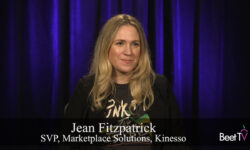LOS ANGELES – The term “programmatic advertising” has negative connotations for television networks that don’t want to see the value of their media inventories plunge. They fear the same “race to the bottom” that was seen in the digital display market, where websites could load up their pages with an almost limitless supply of banner ads.
But broadcasters shouldn’t worry that the same dynamics will apply to television advertising, Chris Maccaro, chief executive of ad-tech company Beachfront Media, said in this interview at Beet.TV’s Beet Retreat.
“We have better controls. We’ve learned a lot on how to drive better yield,” he said. “It’s one of the reasons we tend to use the word ‘automation’ over ‘programmatic’ is because it’s still a little bit of a bogeyman for some.”
Automation can be liberating for media buyers and sellers if it supplants the rote tasks of managing ad campaigns.
“We can all agree that more automation in what has been largely a manual workflow for 70 years benefits both the buy side and sell side of advertising,” Maccaro said. “We have so many resources tied up into pure execution that by automating it, it frees up resources to do other great things on both the buy and the sell side.”
Buying and selling television advertising through automated auctions is forecast to grow with the adoption of technologies that replace legacy systems.
“It really is an infrastructure problem. It’s driving interoperability around systems integration,” Maccaro said. “That largely is what’s holding back more and more automation across this concept of convergent television.”
Limited Supply, Abundant Demand
There has been explosion in the number of connected TV (CTV) services – the app stores for platforms like Amazon’s Fire TV or Roku devices confirm that. However, there is a limited amount of premium video to push through those platforms – especially for live entertainment and news.
“The ecosystem doesn’t lend itself to a concept of a race to the bottom,” Maccaro said. “You have limited supply, and an overabundance of demand….There’s a finite number of places where premium content can get distributed.”
Automation will become more prevalent when media buyers and sellers agree on common technical specifications for television advertising, he said.
“It’s really about everyone agreeing on common specs, and bringing those specs to a platform that can execute,” Maccaro said. “The harder part is getting everyone to agree.”
Learning From Each Other
Linear TV programmers can learn more about automation from digital media, while streaming platforms can learn from linear TV distributors about improving the consumer experience. CTV viewers may see the same spot too many times, or ads from competing brands within the same commercial break. CTV also has the possibility to develop ad formats that are more interactive or shoppable.
“We’re still making mistakes in connected television – and it’s still young,” Maccaro said. “We’ve run very hard at standing up this infrastructure for connected television; we haven’t spent enough time thinking about the consumer experience. That’s coming.”
You are watching coverage from Beet Retreat Santa Monica 2021, presented by FreeWheel, IRIS.TV, Samba TV, TransUnion & Warner Music Group. For more videos, please visit this page.














































